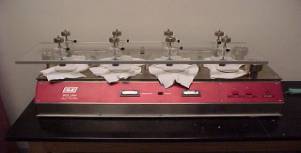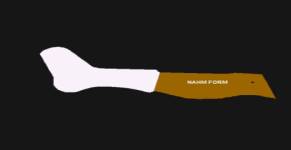Proposed Test Method for Abrasion Resistance of Hosiery (ILE SCR 800 8-Position Sock Tester)
1. Scope
1.1 This test method covers the determination of the resistance to abrasion of hosiery garments using the ILE SCR 800 8-Position Sock Tester1.
1.2 This standard does not purport to address all of the safety concerns, if any, associated with its use. It is the responsibility of the user of this standard to establish appropriate safety and health practices and to determine the applicability of regulatory limitations prior to use.
2. Referenced Documents
2.1 ASTM Standards:
2.1.1 D 123 Terminology Relating to Textiles2
2.1.2 D 1776 Practice for Conditioning Textiles for Testing2
2.1.3 AATCC Standards:
2.1.4 135-1995 Dimensional Changes in Automatic Home Laundering of Woven and Knit Fabrics3
3. Terminology
3.1 Definitions:
3.1.1 abrasion, n. — the wearing away of any part of a material by rubbing against another surface.
3.1.2 courses, n. — in knitted fabrics, the series of successive loops lying crosswise of a knitted fabric, that is, lying at right angles to a line passing through the open throat to the closed end of the loops.
3.1.3 wale, n. — in knitted fabrics, a column of loops in successive courses that is parallel with the loop axes.
3.1.4 For definitions of other textile terms used in this test method, refer to Terminology D123.
3.2 NAHM5 Foot Forms — standard forms used in the hosiery industry for sizing garments.
4. Summary of Test Method
4.1 By subjecting the garment to vertical rubbing against a specified abradant, the resistance to abrasion is measured. An endpoint is determined and discussed in Section 12.
5. Significance and Use
5.1 The measurement of the resistance to abrasion of textile and other materials is very complex. The resistance to abrasion is affected by many factors, such as the inherent mechanical properties of the fibers; the dimensions of the fibers; the structure of the yarns; the construction of the fabrics; and the type, kind, and amount of finishing material added to the fibers, yarns or fabric.
5.2 The resistance to abrasion is also greatly affected by the condition of the tests, such as the nature of the abradant, variable action of the abradant over the area of specimen abraded, the tension of the specimen, and the dimensional changes in the specimen.
6. Apparatus and Materials
6.1 ILE SCR 800 8 Position Sock Tester (see Figure 1), with
6.1.1 Head Weights — 8 total, each weighing 22.66 + 0.1g (0.50 + 0.1 lb.).
6.2 Abradant —TrizactTM4
6.3 Templates,
6.3.1 82+ 2 mm. (3.5 + .0625 in.) and
6.3.2 25+ 2 mm. (1.0 + .0625 in.) in diameter.
6.4 China Marker —The China Marker is used to mark the abrasion testing area around the template.
6.5 Toothbrush —A medium bristle toothbrush is suggested for use of removing pills during abrasion testing.

Figure One: ILE SCR 800 8-Position Sock Tester
Number of Specimens
6.6 Take one specimen per garment.
6.7 In the absence of applicable specifications, evaluate a minimum of three specimens.
NOTE: While data on single-operator precision are not available, the use of three specimens per test is generally accepted in the field.
7. Test Specimens
7.1 After conditioning (see section 8), the test sample is obtained by placing the garment on a NAHM foot form. The form size used should represent the maximum size of the garment, as represented on the label. For example, a 9-11 stretch men’s sock should be tested on an 11.0 M (Male) NAHM foot form (see Figure Two).

Figure Two: Garment on NAHM Form
7.2 After the garment is placed on the NAHM foot form, use the 82 + 2 mm (3.5 + .0625 in.) template is used to obtain a test specimen.
7.3 Mark the circular testing area by centering the template between the toe and heel cups of the bottom of the NAHM foot form. The template should be positioned in a manner that it covers both sides of the NAHM foot form and garment.
7.4 Remove the marked garment from the NAHM form.
7.5 Cut test specimens at least 35.0 + 5.0 mm (1.50 + 0.125 in.) in distance from the testing area of the garment.
8. Conditioning
8.1 Using AATCC Test Method 35, wash and dry test samples three (3) times.
8.2 Condition the specimens under standard conditions of 65 + 2% relative humidity and 2 + 10C (70+ 20F).
9. Preparation of Apparatus
9.1 Installation of TrizactTM4
9.1.1 Place the 82 + 2 mm. (3.5 + .0625 in.) diameter abrasive on the sample holder.
9.1.2 Place the 25 + 2 mm. (1.0 + .0625 in.) diameter abrasive on the abrasion holder.
9.2 Adjustment of ILE SCR 800 8 Position Sock Tester
9.2.1 Turn the machine ON.
9.2.2 Set all cycle counters to zero.
10. Procedure
10.1 Conduct the test in the standard atmosphere for testing textiles.
10.2 Place the test specimen on the sample holder with the wales of the garment running parallel to the abradant plate’s direction of travel.
10.3 Place the head weight on the motion plate.
10.4 Push START button.
10.5 As the ILE sock tester runs, observe the specimen(s).
10.6 Use a toothbrush to gently remove pills of matted fibers interfering with proper contact between the specimen and abradant during the test.
10.7 When the specimen abrades to the endpoint, stop the machine.
10.8 Record the number of cycles to reach the end point.
11. Interpretation of Results
11.1 Determine the end point by one of the following methods as specified:
11.1. Failure—Abrade the specimen until all fibers in a section of the abrasion area are worn off.
11.1.2 Visual Rating —Abrade the specimen a specified number of cycles and evaluate visually for the effect of the abrasion on fabric structure.
12. Report
12.1 State that the specimens were tested as directed in the specified test method. Describe the material or product sampled and the method of sampling used.
12.2 Report the following information:
12.2.1 Type of abradant,
12.2.2 Condition of the specimens (in equilibrium with the standard atmosphere for testing textiles),
12.2.3 Number of cycles to reach the end point and end point type,
12.2.4 Any deviations from the standard test procedure.
13. Precision and Bias
13.1 Precision—the precision of this test method for measuring the abrasion resistance of hosiery by the ILE SCR 800 8-Position Sock Tester is being established.
13.2 Bias— No justifiable statement can be made on the bias for abrasion resistance of hosiery, since the value varies in fiber and style characteristics.
Keywords
14.1 abrasion: hosiery: NAHM:; endpoint: wale
<< Previous Page >>